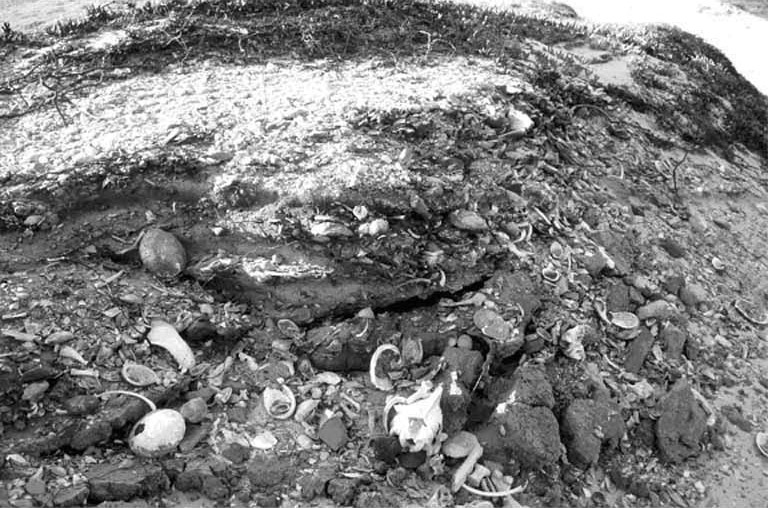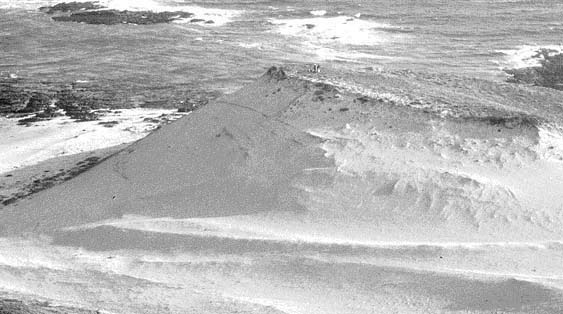Research Report
Archeology, Ancient Human Impacts on the Environment, and Cultural Resource Management on Channel Islands National Park, California
by Torben C. Rick and Jon M. Erlandson
Motivated by contemporary environmental challenges, archeologists, ecologists, and other researchers are investigating examples of ancient human impact on the environment.(1) Historical ecology—an interdisciplinary field focused on understanding how people have interacted with and altered the environments that they have inhabited through time—supplies a framework for investigating long-term human environmental relationships.(2) Archeology and other historical disciplines provide insight into the impacts of ancient people on the environment, how people responded to environmental degradation, and the types of solutions and catastrophes that emerged.
A collaborative and multidisciplinary project was recently initiated to investigate ancient human impacts on what is now Channel Islands National Park in California.(Figure 1) The Channel Islands contain the earliest evidence of maritime people in North America and a spectacular record of coastal hunter-gatherers that spans the last 12,000 years.(3) The research project integrates cultural resource management, extensive radiocarbon dating, and salvage excavation to produce a long-term and relatively comprehensive picture of local environments and human impacts on the marine and terrestrial ecosystems of Channel Islands National Park. The initial phase of the study demonstrates that the Channel Islands may soon provide information of regional and global significance to understanding ancient human impacts on the environment.
 |
Figure 1. The study is located in the Northern Channel Islands and the Santa Barbara Channel area. (Courtesy of the authors.) |
Channel Islands Shell Middens as Ecological Laboratories
The Chumash and Tongva peoples of the California coast and Channel Islands were among the most populous hunter-gatherers in the world. They often lived in large villages or towns with a hierarchical sociopolitical organization and complex exchange networks and interaction spheres. The Chumash and their predecessors left behind a well-preserved and continuous archeological record of coastal land use, subsistence, and other activities.(Figure 2)
Most archeological sites on the Channel Islands are large shell middens, composed of the refuse of the site occupants, including the remains of a variety of shellfish, fish, birds, and mammals.(Figure 3) Although the preservation and stratigraphic integrity of Channel Islands' archeological sites are generally outstanding, many of these shell middens are heavily eroding and have been impacted by cultural and natural processes. Through the identification of various shells and bones, the shell middens provide an ideal source of ecological information that can be used to reconstruct local marine and terrestrial ecosystems, human subsistence patterns, technology, and other aspects of society.
 |
Figure 3. The eroding midden deposit reveals shell, sea mammals, and fish bones. (Courtesy of the authors.) |
By comparing the animal remains from a variety of sites or components dating to different time periods, the project investigates how ecological communities varied through space and time, and how humans influenced and were influenced by these biotic changes. Such data are crucial to designing effective restoration and remediation plans for both terrestrial and marine ecosystems.(4)
Cultural Resource Management and Historical Ecology
The initial phases of our study involved collecting samples from sites for radiocarbon dating and excavation to obtain information on human subsistence and interaction with the environment. These data established a chronology of when sites were occupied, the activities people engaged in at those sites, and ultimately how these patterns changed through time and across space. The research has been management-oriented, targeting sites that have been heavily impacted by marine and wind erosion.(5) All of the excavations have been conducted in eroding and threatened sites in consultation with Channel Islands National Park staff and local Chumash representatives. Research efforts are balanced with developing effective strategies for managing and preserving the archeological record.
Ancient Human Impact on the Channel Islands
The research is still in its early phases, but data from archeological sites spanning the last 10,000 years provides one of the longest records for a coastal region in the world. A variety of topics are investigated, including the role of ancient human hunting on seal and sea lion populations and ecology, human harvesting of shellfish beds, human hunting of sea otters, human fishing strategies, and comparing the effects of modern human impacts with those of Native American practices.
The project's preliminary findings are interesting.(6) The data illustrate dramatic differences between contemporary Euroamerican impacts (overgrazing, overfishing, etc.) and the impacts caused by the Chumash and their predecessors. The data suggest that people hunted and foraged for a similar suite of animals in the Channel Islands' marine environments for over 10,000 years. The Chumash and their ancestors may have caused some brief impacts on mussel beds, kelp forests, and other resources, but our data also indicate periods of rebound and recovery.(7)
Findings regarding the prehistoric period stand in sharp contrast to the relatively rapid and intense declines caused during the historic era, when marine mammals were hunted to local extinction, overgrazing drastically impacted terrestrial habitats, and oil spills, overfishing, and other human related disturbances devastated the local marine environment. Fortunately, much of the Channel Islands area, including surrounding waters, is under Federal or other conservation-oriented stewardship that is leading to the restoration and conservation of its natural and cultural resources.
Over the next several years, additional fieldwork and laboratory analysis will build on the preliminary study. Future research will continue to target threatened and eroding archeological sites, with the goal of increasing collaboration with ecologists, marine biologists, botanists, resource managers, restoration ecologists, the Chumash, and the public. The collaborative endeavor will provide a means to understand the long-term evolution of Channel Islands' environments and a baseline for preserving and restoring the resources for the future. Finally, the data illustrate the importance of integrating and balancing effective resource management strategies and broad archeological research issues.
Acknowledgments
Our research is supported by Channel Islands National Park, the Western National Parks Association, the U.S. Navy, the National Science Foundation, and the University of Oregon. Thanks are extended to Ann Huston, Georganna Hawley, Don Morris, and Steve Schwartz for continued support and encouragement of this research.
About the Authors
Torben C. Rick and Jon M. Erlandson can be reached at the Department of Anthropology, University of Oregon, Eugene, OR 97403-1218, E-mail torrey@uoregon.edu, jerland@uoregon.edu.
Notes
1. Charles E. Kay and Randy T. Simmons, eds. Wilderness and Political Ecology: Aboriginal Influences and the Original State of Nature (Salt Lake City: University of Utah Press, 2002); Patrick V. Kirch, John R. Flenley, David Steadman, Frances Lamont, and Stewart Dawson, "Ancient Environmental Degradation," National Geographic Research 8 (1992): 166-179; Charles Redman, Human Impact on Ancient Environments (Tucson: University of Arizona Press, 1999).
2. Carole L. Crumley, ed., Historical Ecology: Cultural Knowledge and Changing Landscapes (Santa Fe, NM: School of American Research, 1994).
3. Jon M. Erlandson, Torben C. Rick, and René L. Vellanoweth, "Human Impacts on Ancient Environments: A Case Study from California's Northern Channel Islands," in Scott M. Fitzpatrick, ed., Voyages of Discovery: The Archaeology of Islands (Westport, CT: Praeger Publishers/Greenwood Publishing Group, in press); Torben C. Rick, Jon M. Erlandson, and René L. Vellanoweth, "Paleocoastal Marine Fishing on the Pacific Coast of the Americas: Perspectives from Daisy Cave," California, American Antiquity 66 (2001): 595-613.
4. Jeremy B. C. Jackson, Michael X. Kirby, Wolfgang H. Berger, Karen A. Bjorndal, Luis W. Botsford, Bruce J. Borque, Roger H. Bradbury, Richard Cooke, Jon Erlandson, James A. Estes, Terence P. Hughes, Susan Kidwell, Carina B. Lange, Hunter S. Lenihan, John M. Pandolfi, Charles H. Peterson, Robert S. Steneck, Mia J. Tegner, and Robert R. Warner, "Historical Overfishing and the Recent Collapse of Coastal Ecosystems," Science 293 (2001): 629-638.
5. Jon M. Erlandson and Madonna L. Moss, "The Systematic Use of Radiocarbon Dating in Archaeological Surveys in Coastal and Other Erosional Environments," American Antiquity 64 (1999): 431-443; Torben C. Rick, "Eolian Processes, Ground Cover, and the Archaeology of Coastal Dunes: A Taphonomic Case Study from San Miguel Island, California, U.S.A.," Geoarchaeology 17 (2002): 811-835.
6. Jon M. Erlandson, Torben C. Rick, and René L. Vellanoweth, "Human Impacts on Ancient Environments: A Case Study from California's Northern Channel Islands."
7. Ibid.

